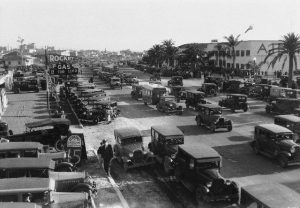There’s a photo floating around Facebook again. You’ve probably seen it.
It shows a couple of 1930s streetcars, some early sedans, and a row of pedestrians framed by weathered buildings. The caption reads something like:
“Pacific Highway cuts through the heart of Little Italy in San Diego, where cars, pedestrians, and streetcars move through the vibrant community. The streets are lined with local shops and restaurants, many catering to the large Italian-American population. The scene in 1932.”
Sounds lovely, right? Like something out of a sepia-toned dream. A nice slice of heritage you can share on with a heart emoji and a plate of digital spaghetti.
Nice try, but no cigar.
Those who grew up in that city know the real artery through Little Italy is India Street—always has been. That’s where the cafés, bakeries, and corner bars thrived. That’s where Italian families lived, worked, worshipped, and argued over meatballs.
Pacific Highway? In 1932, it wasn’t a scenic stroll—it was a machine shop corridor. A noise corridor. A stretch of steel-stained pavement that smelled more like hot metal and solvent than marinara.
The shops weren’t quaint. They were industrial. The crowd wasn’t tourists. It was riveters and welders. It was the ground zero of San Diego’s growing aircraft and maritime manufacturing base—the place where the city built its future, one torque wrench at a time.
But none of that makes it into the caption. Because the caption isn’t written by a historian, or a local, or even a person half the time. It’s written by a bot. A machine. A content farm algorithm whose only job is to crank out shareable, feel-good lies.
Welcome to the Age of Artificial Nostalgia.
Machines That Misremember For You
This isn’t just lazy copywriting. It’s weaponized inaccuracy.
Content farms—many of them overseas—are scraping old photos from digitized archives and pushing them out with captions generated by artificial intelligence. These AIs don’t know a rivet from a ravioli. They’re trained to write flowery filler, not factual history.
So they sprinkle in phrases like “vibrant community,” “local shops,” “period clothing” and “the smell of fresh bread”—even if the photo is of a loading dock in a grease pit on a Tuesday in 1932.
No Editors, No Facts, Just Feels

Pacific Highway looking south from Laurel Street 1932 Photographer: Passmore, Lee (Levi Nickerson), 1874-1958 Source: San Diego Historical Society
This is what happens when you take journalism and human fact-checkers out of the equation.
I worked as a copy editor at a daily. You couldn’t write “this is a 1932 photo of Little Italy” unless you’d confirmed the date, the location, the source, and what was actually happening in the damn photo.
For example, in the photo, the building on the right is the San Diego Airport at Lindbergh Field.
Now? AI doesn’t verify anything. It just stitches together clichés and guesses. Worse, it makes it sound good—so good that people stop asking whether it’s true. They just hit share.
Nostalgia Is Easy to Fake
The reason these lies work is because they tell people the version of history they want to believe:
-
That our cities were always charming and clean
-
That every neighborhood was a tight-knit community
-
That every face in an old photo was someone proud, hopeful, and American
But history is messier than that. More sweat, more soot, more struggle. And definitely fewer lattes.
So What Can You Do?
Here’s how to fight back:
- Reverse image search the next photo that smells too sweet. Tools like Google Images or TinEye can tell you where it really came from.
- Ask better questions: Was that really Little Italy? What street is that? What’s the building say?
- Look for the scent of AI: Generic adjectives. Emotional appeals. Passive voice. No details about who took the photo or what was really happening? It’s probably fake.
- Support real sources: Follow your local archives, libraries, and historical societies. Share their photos with their captions.
- Don’t just react—correct: Comment. Post the real location. Link to the source. Not to shame—to educate.
Because This Stuff Matters
This isn’t just an innocent mislabeling. It’s the start of a deeper erasure.
If we let bots rewrite the past, we lose the context for what shaped our neighborhoods, our cities, our people. We lose the hard parts, the beautiful, ugly parts. We lose the truth, and the present loses the past.
The people who built Pacific Highway didn’t do it for a camera. They did it with burned hands and bad backs, for a city that was trying to muscle its way onto the map. And if we let that story get replaced with some AI-hallucinated café culture fantasy, then we’ve failed them.
History deserves better than a caption written by a toaster.
